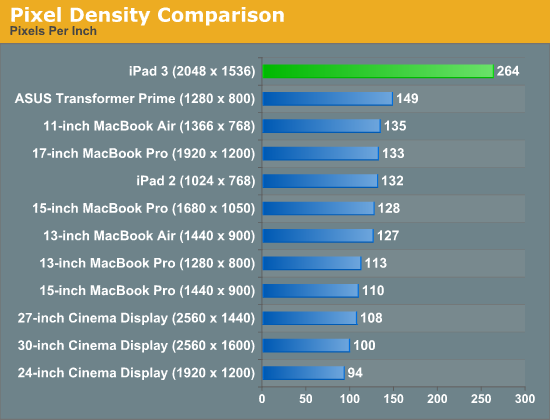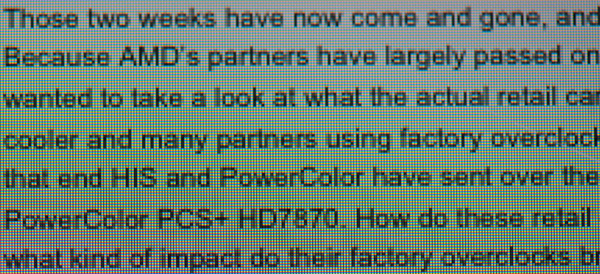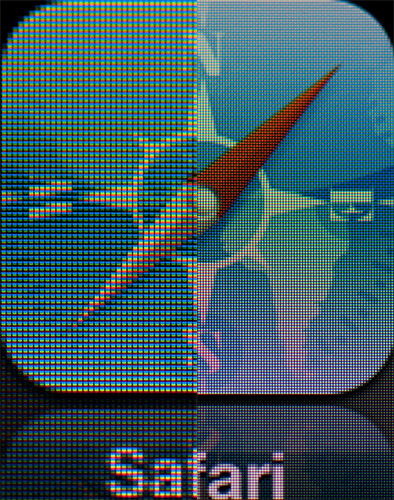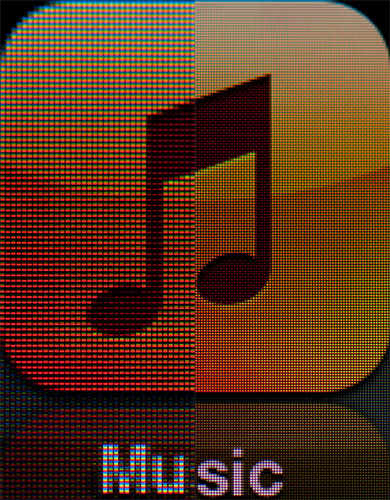The new iPad: Retina Display Analysis
by Anand Lal Shimpi on March 19, 2012 5:49 PM ESTWe're hard at work on our review on the new iPad but with a fair bit of display analysis under our belts I thought a quick post might be in order. One of the major features of the new iPad is its 2048 x 1536 Retina Display. Apple kept the dimensions of the display the same as the previous two iPad models, but doubled the horizontal and vertical resolution resulting in a 4x increase in pixels. As display size remained unchanged, pixel density went through the roof:

Although the iPad 2 has a fairly high pixel density compared to most of Apple's Mac/display lineup, you're more likely to hold a tablet closer to your eyes which made the low resolution/pixel density problematic. The new iPad addresses this issue as you can see from the chart above. I can't focus closely enough to the panel to actually make out pixels on the new iPad, much less at a normal viewing distance. With the aid of a macro lens we can definitely identify individual pixels. The improvement over the iPad 2 display is striking:
To the left we have the original 1024 x 768 panel, and to the right we have the new Retina Display. At this distance you can still identify individual pixels, an ability that quickly vanishes at normal viewing distances. The Music app icon is an even better example of what you gain from the newer display as it has more high contrast edges that appear more aliased on the 1024 x 768 panel:
The old iPad's 1024 x 768 resolution was fairly bothersome when it came to reading text on web pages or books. Most Android tablets standardizing on 1280 x 800 offered an advantage in that respect, albeit not delivering significantly higher pixel density. The new iPad completely resolves this issue. Hover over the links below to see roughly the same paragraph of text from our retail Radeon HD 7870 review on the iPad 2, new iPad and ASUS Transformer Prime:

| Apple iPad 2 | Apple iPad (3rd gen) | ASUS TF Prime |
| original | original | original |
While it's still obvious that you're looking at a screen and not an e-ink display, the pixels perform a good disappearing act on the new iPad.












172 Comments
View All Comments
dagamer34 - Tuesday, March 20, 2012 - link
Operating systems and apps haven't supported high DPI displays on smaller screens. For the longest time, OS vendors believed that vector graphics were the solution, but pixel doubling is a good enough solution that it's clearly the path forward now.gorash - Tuesday, March 20, 2012 - link
Maybe battery is the issue.tipoo - Tuesday, March 20, 2012 - link
I'm guessing Apple will keep moving Retina-ish displays up the line. First 3.5" displays, then 9.7", probably 11" and 13" Airs at the same time next, then the Macbook Pros.aranyagag - Monday, March 19, 2012 - link
I am a person who never even considers apple products-- I am as much of an anti apple fanboy as it is possible to be.Unfortunately, their products -- Display wise have EXACTLY what I want. Why the hell do the windows / android camp not GET IT. I mean Macbooks pros have had 16:10 MATT screens and now the ipad has 4:3 wide gamut(for tablets) display
kmmatney - Monday, March 19, 2012 - link
I'm just waiting for a someone to step up and make a 16:10 windows laptop. If someone wants to stand -out from the crowd, now is their chance.Solandri - Monday, March 19, 2012 - link
Display-wise, Apple has always been at the forefront since their products have traditionally sold to graphics artists and photographers. Mac OS supported 24-bit colors back when the best Windows hardware supported 16-bit (15-bit really). Resolutions could go higher. Apps were color space-aware. Color calibration and a LUT were supported. Monitors were color-calibrated out of the factory for sRGB, so you got semi-accurate colors even if you didn't have calibration equipment. etc. Their only faux pas IMHO was switching the Macbooks to glossy TN panels.gorash - Tuesday, March 20, 2012 - link
OLED > LCD. Galaxy Tab 7.7 has an OLED screen.doobydoo - Tuesday, March 20, 2012 - link
The Galaxy Tab also has awful difficulty running the previous of version of Android, since it doesn't even have ICS yet.It's also more expensive than even the new iPad, in the UK.
The Galaxy 7.7 is £429
The new iPad starts at £399, the old one £329.
You would have to be mental to pay more for a slower, laggy, lower resolution tablet which doesn't even have the latest operating system out.
Btw, the screen on the new iPad is LCD, but not just LCD. It has IPS technology which addresses all of the issues of LCD, meaning that to normal users it's every bit as good.
ssddaydream - Tuesday, March 20, 2012 - link
You are probably correct for that for most people, IPS LCD is perfectly good.For me, I literally can't stand any LCD I've seen.
The iPhone 4 screen annoys me.
I still have a Sony Artisan CRT and I use a SAMOLED+ phone.
I won't even bother with a tablet until there is a high-res SAMOLED+ display with Windows 8. Android would probably be acceptable, but I'd prefer Windows 8.
myhipsi - Tuesday, March 20, 2012 - link
You're just a contrarian. How does the iPhone 4 screen "annoy" you? It's, by far, one of the best phone displays on the market. As for LCD monitors? A Dell u3011 absolutely smokes that Sony CRT in every area other than black level and refresh rate.